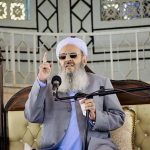 Note: Some national media sources have been publishing articles to compare the situation of both Sunni community of Iran and Shiite community of Saudi Arabia. These elements claim that Sunni community in Iran has more civil rights and liberties than Shiites in Saudi. Dear readers, the following article is a brief comparison of the two communities, the situation is being presented, you can analyze the matter from a different side. We only provide some credible information; final judgment is up to you.
Note: Some national media sources have been publishing articles to compare the situation of both Sunni community of Iran and Shiite community of Saudi Arabia. These elements claim that Sunni community in Iran has more civil rights and liberties than Shiites in Saudi. Dear readers, the following article is a brief comparison of the two communities, the situation is being presented, you can analyze the matter from a different side. We only provide some credible information; final judgment is up to you.
Republic & Kingdom:
“Republic” and “Kingdom” are two well-known types of governing around the world. In republican states, masses elect their rulers, policymakers and chiefs of states; in other words, people, regardless to difference of language, skin color, religion and race independently cost their votes and give approval to leaders, eventually those who get vote of majority have right to hold the government.
“Islamic Republic”:
When the title “republic” appears with affix of “Islamic”, it means that the rules of that state are based on Islam. The Islamic laws and jurisprudence urge on taking care of the civil and religious rights of minorities, it prohibits from injustice actions.
On the other hand, “kingdom” system of governing means rule of royal family on a country, they hold key posts and make mostly the interior and foreign policies.
The Islamic Republic of Iran came into existence after a long nation-wide protest and struggle which succeeded to defeat the ex-kingdom regime of Iran, the world saw the victory of a public revolution in February 1979 in Iran. The Iranian nation, Shiites and Sunnis, backed the anti-Shah movement due to its motto “Islamic Republic”.
In short, key posts are distributed in the kingdom system by SELECTION and in democratic and republican states by ELECTIONS.
After knowing these details, it looks very amazing to compare “Islamic Republic” of Iran with the “Kingdom of Saudi Arabia”. It astonishes more to analyze the situation of Iran’s Sunnis in the light of Saudi’s Shiites.
Jobs distribution in Iran & Saudi:
It must be kept in mind that in the KSA, only high offices and important appointments are under the control of royal family, king Abdul Aziz; while for lower posts nationality is the only required point not sect like Shia and Sunni. As Saudi Shiites have been working in various departments side by side of their Sunni country-fellows. They can get jobs in armed forces and security services without any obstacles; even till recent time, the chief of police in Medina Munawwarah was a Shiite citizen. The Saudi ambassador in the Iranian capital, Tehran and Saudi Consul in Mashhad, the second-largest Iranian city, were Saudi Shiites.
Besides, there are five Shia members in “Selective Chamber” or Consultative Council of Saudi Arabia among 150 members.
Unlike Saudi Arabia, Sunni citizens are questioned about their sect and school of thought in each step when they apply for a job. Important offices are ‘Prohibited Tree’ for Sunnis in Iran, rather the rulers have been neglecting Sunni citizens at distribution of low and small posts. While they claim the ruling system is based on ‘democracy’ and ‘republic’.
The Sunni community of Iran is the second-largest majority of Iran. The community played an important and active role to bring revolution against the Shah’s regime along with the rest of public. After victory, Sunnis remained favoring the new state, warm welcome of officials in Sunni-majority areas is an evidence of this continuous support. Despite all of this, since the victory of the Revolution none of Sunnis has been appointed as a minister, vice minister, ambassador or member of any Iranian embassy, vice president or governor of any province even with 90% Sunni population. In armed offices, Sunnis are present only as common soldiers and constable, not more.
Take the example of Sunni-majority province, Sistan & Baluchistan, where Sunnis take 5% of key offices out of one hundred high offices. There is no a single Sunni member in the Provincial Security Council. From 170 members of Provincial Internal Council just 13 are Sunnis. As well as, there is no any Sunni member in the Guardian Council (Shura Negahban) and other Supreme departments.
“Are you a Shiite or Sunni?” this question is in front of oppressed citizens in most of the official departments, even in some hospitals this question is asked from patients.
Problems in religious affairs:
It was the case in distribution of posts; Sunni citizens have been suffering from discriminative official treatment in their religious affairs as well. Ban on the constitutional civil and religious rights, interference in the religious and educational matters of Sunnis, prohibition of building a mosque for more than one million Sunni citizens in Tehran, forbiddance of Sunnis to offer Eid and Friday prayers in big cities as well as offering five-time prayers in congregation in some other cities are the matters which have made the Sunni community anxious.
On the other hand, Shiite citizens of Saudi Arabia have a grand mosque in Riyadh where they establish Friday prayers. In all areas and cities where they live, they have separate worship places. Even Shias have a “Husainiah” (Imam Bargah) in Medina Munawwarah which was inaugurated by ex-president of Iran, Akbar Hashemi Rafsanjani.
Apart from this, unlike Saudi Shiites, most of the Iranian Sunnis live in border areas and they are so weak and vulnerable economically. Where Saudi Shias are strong in this regard and own big trade companies, they do not face discriminative acts in this field.
If somebody takes out the glass of partiality and prejudice from his eyes, he will judge that Shias of the KINGDOM of Saudi Arabia are in quite better condition than Sunnis of the ISLAMIC REPUBLIC of Iran.
It is better for pro-state elements to compare the conditions of Iran’s Sunnis to Shia minorities of a democratic/republic state if they are eager to do so. It seems more logical to look at the situations of Shia minorities of Iran’s neighbors, Afghanistan and Pakistan.
Shias in Pakistan and Afghanistan:
An eye-reach shows that Shias enjoy absolute freedom in these two countries; as vice president, some governors and ministers are Shiite in Afghanistan. The president of Pakistan belongs to Shia community, there are some other important public figures belong to Shia community in Pakistan, even in Army and intelligence services. Religiously, Shias enjoy full freedom, as there are many Shiite worship places in Kabul and Islamabad and wherever they live from small to big cities.
Finally, the Iranian rulers and their defenders should try to be ideal for other states in dealing with religious and ethnic minorities instead of comparing minorities. They should prove that “Islamic Republic of Iran” believes in justice and equality among different sects and races.
SunniOnline.us










Love and respect from Pakistan